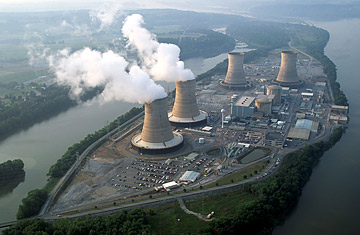
Three Mile Island Nuclear Power Plant
(6 of 11)
Between sips of coffee at a roadside diner in the rich farm land near Three Mile Island, area residents kept citing the reassurances of company officials that there was no need for concern. As Vice President Herbein had been saying: "This accident is not out of the ordinary for this kind of reactor. It was not unexpected.' President Creitz meant to be equally low key, but in retrospect his words were unwittingly chilling. Said he: "The same occurrence happened two or three times in 1974 on Unit No. 1, but the tanks didn't spill." It was about this time, 11 a.m. on Thursday, that plant officials first disclosed that some of the fuel rods had been damaged on Wednesday, when the emergency cooling system had been briefly shut off, apparently because of an equipment failure that was quickly corrected. Company officials said less than 1% of the 37,000 rods had been damaged; by week's end NRC investigators increased the estimate to 60%.
By Friday all of the sanguine assurances were blown away by additional releases of radioactivity into the skies above the plant. According to NRC spokesmen, early morning workers had been trying to remove some radioactive water from the pump building. As the water flowed into a storage tank, the temperature and pressure rose. A valve automatically opened, letting some of the gas escape. The building's ventilation system sucked up the gas and blew it out a stack. At that moment, a state and federal monitoring crew flying over the stack recorded an alarming increase in radiation.
Soon there were reports of "uncontrolled new radiation" from the plant. Screamed a headline in the New York Post: NUKE LEAK GOES OUT OF CONTROL. Company officials insisted again that an emergency back-up system had worked as planned and nothing was out of control. Once more there was confusion as spokesmen for the various parties involved in coping with the crisis argued about whether or not the release had been unexpected or intentional.
For the first time company officials conceded that the reactor core was not cooling down, as they had been assuring the public for three days. The average temperature in the core had remained stubbornly at 280° F., while some of the core's fuel rods, which are filled with fissionable uranium, showed spots as high as 600°. When reporters pressed for more information, Vice President Herbein turned hostile. Said he: "I don't know why we need to tell you each and every thing we do. People around the plant have to recognize that we have to get on with our job."
In Harrisburg, Governor Thornburgh, who had carefully avoided any statements that might cause panic, even while remaining skeptical of the utility company's pacifying pronouncements, decided it was time to warn people living near Three Mile Island to take prudent precautions. First, he asked all residents within ten miles to remain inside their homes with their windows closed (though in fact that provides scant protection from radiation). Then he urged pregnant women and young children within a five-mile radius to move out, and closed schools. He also took the broader step of advising the four counties in the area, where nearly 900,000 people live, to prepare for evacuation. The Harrisburg airport was closed for several hours because of the radiation hazard.
